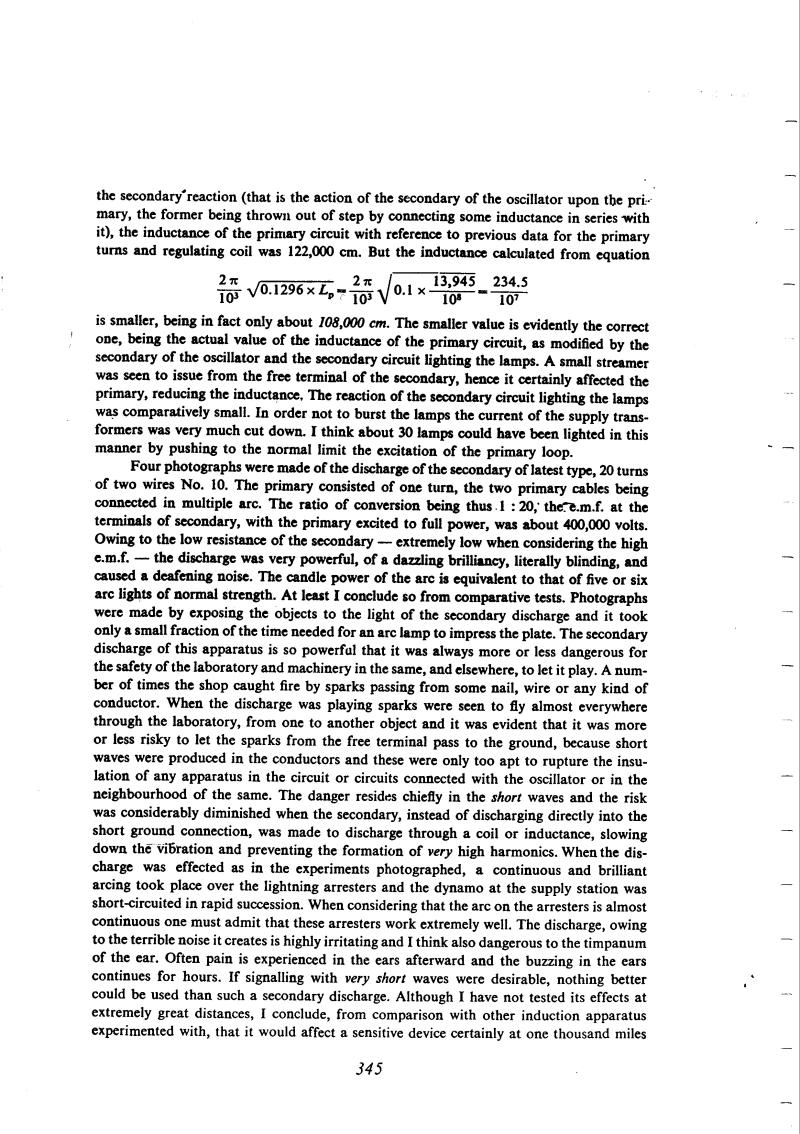
Nikola Tesla Books
the secondary reaction (that is the action of the secondary of the oscillator upon the primary, the former being thrown out of step by connecting some inductance in series with it), the inductance of the primary circuit with reference to previous data for the primary turns and regulating coil was 122,000 cm. But the inductance calculated from equation
$! {{2 \pi \over 10^{3}} \sqrt{0.1296 \times L_{p}}} $! = $! {{2 \pi \over 10^{3}} \sqrt{0.1 \times {13,945 \over 10^{8}}}} $! = $! {234.5 \over 10^{7}} $!
is smaller, being in fact only about 108,000 cm. The smaller value is evidently the correct one, being the actual value of the inductance of the primary circuit, as modified by the secondary of the oscillator and the secondary circuit lighting the lamps. A small streamer was seen to issue from the free terminal of the secondary, hence it certainly affected the primary, reducing the inductance. The reaction of the secondary circuit lighting the lamps was comparatively small. In order not to burst the lamps the current of the supply transformers was very much cut down. I think about 30 lamps could have been lighted in this manner by pushing to the normal limit the excitation of the primary loop.
Four photographs were made of the discharge of the secondary of latest type, 20 turns of two wires No. 10. The primary consisted of one turn, the two primary cables being connected in multiple arc. The ratio of conversion being thus 1:20, the e.m.f. at the terminals of secondary, with the primary excited to full power, was about 400,000 volts. Owing to the low resistance of the secondary - extremely low when considering the high e.m.f. - the discharge was very powerful, of a dazzling brilliancy, literally blinding, and caused a deafening noise. The candle power of the arc is equivalent to that of five or six arc lights of normal strength. At least I conclude so from comparative tests. Photographs were made by exposing the objects to the light of the secondary discharge and it took only a small fraction of the time needed for an arc lamp to impress the plate. The secondary discharge of this apparatus is so powerful that it was always more or less dangerous for the safety of the laboratory and machinery in the same, and elsewhere, to let it play. A number of times the shop caught fire by sparks passing from some nail, wire or any kind of conductor. When the discharge was playing sparks were seen to fly almost everywhere through the laboratory, from one to another object and it was evident that it was more or less risky to let the sparks from the free terminal pass to the ground, because short waves were produced in the conductors and these were only too apt to rupture the insulation of any apparatus in the circuit or circuits connected with the oscillator or in the neighbourhood of the same. The danger resides chiefly in the short waves and the risk was considerably diminished when the secondary, instead of discharging directly into the short ground connection, was made to discharge through a coil or inductance, slowing down the vibration and preventing the formation of very high harmonics. When the discharge was effected as in the experiments photographed, a continuous and brilliant arcing took place over the lightning arresters and the dynamo at the supply station was short-circuited in rapid succession. When considering that the arc on the arresters is almost continuous one must admit that these arresters work extremely well. The discharge, owing to the terrible noise it creates is highly irritating and I think also dangerous to the tympanum of the ear. Often pain is experienced in the ears afterward and the buzzing in the ears continues for hours. If signalling with very short waves were desirable, nothing better could be used than such a secondary discharge. Although I have not tested its effects at extremely great distances, I conclude, from comparison with other induction apparatus experimented with, that it would affect a sensitive device certainly at one thousand miles
345
January 1
On photograph XVII, bulbs are shown connected to the resonant circuit made of one turn rectangular in shape. According to data mentioned the square edge is 1.3 meters away from the oscillator secondary coil. The capacitance of the oscillating circuit consists of two capacitors connected in parallel. The bulbs are connected in parallel. The square turn inductance Tesla calculated according to an equation for two parallel conductors' inductance as those are two parallel conductors pairs connected in series. When the calculation is done as per equation for a square coil (Fleming, p. 155):
L = 81 (ln $! {d \over r} $! - 0.774)
The value obtained is 12.6% smaller than the one found in the notes. The calculated value of a square coil circuit resonant frequency is due to that somewhat higher, and therefore the inductance of the oscillator primary coil calculated as Tesla does it is even smaller. In fact, due to the existence of a very good coupled secondary the oscillator has complicated the oscillating spectrum with probably the strongest component in the frequency of the oscillating circuit with a square coil.
Related to four secondary coil photographs with extensive discharge the remark about energy transmission over a distance is interesting.
Tesla concluded on the basis of comparisons with achieved induction apparatus that the signal registration could be performed at the distance of 1000 or more miles, even over the earth globe surface. There is no data in the notes about measurements over longer distances, and in article(41) written immediately after the finish of the work at Colorado Springs, he says that he observed the effects at a distance of approximately 600 miles.

